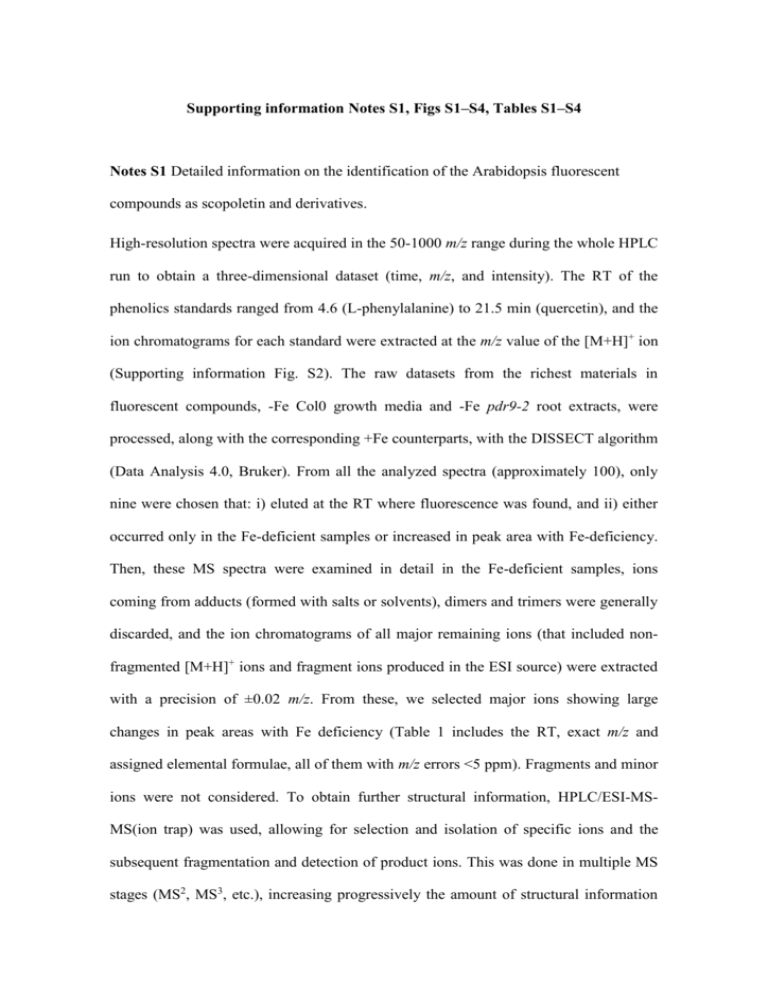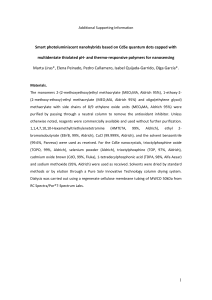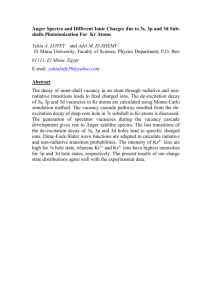nph12471-sup-0001-FigS1-S4_TableS1-S4_NoteS1
advertisement

Supporting information Notes S1, Figs S1–S4, Tables S1–S4 Notes S1 Detailed information on the identification of the Arabidopsis fluorescent compounds as scopoletin and derivatives. High-resolution spectra were acquired in the 50-1000 m/z range during the whole HPLC run to obtain a three-dimensional dataset (time, m/z, and intensity). The RT of the phenolics standards ranged from 4.6 (L-phenylalanine) to 21.5 min (quercetin), and the ion chromatograms for each standard were extracted at the m/z value of the [M+H]+ ion (Supporting information Fig. S2). The raw datasets from the richest materials in fluorescent compounds, -Fe Col0 growth media and -Fe pdr9-2 root extracts, were processed, along with the corresponding +Fe counterparts, with the DISSECT algorithm (Data Analysis 4.0, Bruker). From all the analyzed spectra (approximately 100), only nine were chosen that: i) eluted at the RT where fluorescence was found, and ii) either occurred only in the Fe-deficient samples or increased in peak area with Fe-deficiency. Then, these MS spectra were examined in detail in the Fe-deficient samples, ions coming from adducts (formed with salts or solvents), dimers and trimers were generally discarded, and the ion chromatograms of all major remaining ions (that included nonfragmented [M+H]+ ions and fragment ions produced in the ESI source) were extracted with a precision of ±0.02 m/z. From these, we selected major ions showing large changes in peak areas with Fe deficiency (Table 1 includes the RT, exact m/z and assigned elemental formulae, all of them with m/z errors <5 ppm). Fragments and minor ions were not considered. To obtain further structural information, HPLC/ESI-MSMS(ion trap) was used, allowing for selection and isolation of specific ions and the subsequent fragmentation and detection of product ions. This was done in multiple MS stages (MS2, MS3, etc.), increasing progressively the amount of structural information gained. A comprehensive study of the MSn of phenolics standards was used to build a fragmentation template (see Table 2 for the m/z values and relative intensities of the fragments). Annotations proposed for compound 9 are in agreement with the RTs, which indicate relative polarities in the order fraxetin > scopoletin > isofraxidin > 9. Compound 9 produced MS2 fragment ions matching well with that of isofraxidin (Tables 1 and 2), indicating that the methoxy group must be in the benzenic ring as it occurs in the standard, since a methoxy group in the heterocyclic ring would yield a different MS2 fragmentation pattern. The 5- position is the only one possible in the benzenic ring apart from the 8- occurring in the standard. A similar glucosyl moieity loss was also found in the standard glucoside of esculetin (esculin), which produced an ion at m/z of 179.0343 corresponding to the aglycone (esculetin). This, along with the fact that 1-5 eluted at RTs close to that of esculin (8.8 min), much lower than those of all non-glucosylated coumarins (13-16 min), supports a putative annotation as glucosides of coumarins. In fact, the MS2 of 1-5 (Table 1) show that the isolation and subsequent fragmentation of the parent ions (387, 355, 357, 401 and 387 m/z, respectively) produced generally just one major fragment ion in each case (at 225, 193, 195, 239 and 225 m/z, respectively), all consistent with the loss of the glucosyl moiety, with the rest of fragments having generally relative intensities below 10%. A similar MS2 fragmentation pattern was found for esculin (m/z of parent and major fragment ions of 341 and 179, respectively, with a loss of -162 Da; Table 2). Therefore, compounds 1-5 were confirmed to be glucosides, and their identity was further deciphered by MS3 using as a model the fragmentation of esculin. The esculin MS3 spectrum 341179 produced the same fragment ions than those present in the aglycone esculetin MS2 (Table 2), confirming that esculin is initially fragmented in MS2 in a very abundant ion corresponding to the aglycone after the loss of the glucosyl moiety. Compound 2 was identified as glucoside of scopoletin (scopolin), since the MS3 spectrum 355193 produced several fragment ions matching with those present in the scopoletin MS2 (Tables 1 and 2). Compounds 1 and 5 were annotated as two different glucosides of dihydroxyscopoletin. First, their MS3 spectra, in both cases 387225, produced several m/z losses similar to those observed in the MS2 spectra of the coumarins studied (see Supporting information Fig. S3), indicating that they can be two glucosides of a coumarin with a [M+H]+ 225 m/z. Taking advantage of the fact that ions with m/z 225.0393 and 225.0386 were observed in the TOF analysis, we were able to assign the elemental formula C10H9O6 to the 225 m/z coumarin (with an error <4 ppm). Both this m/z and the elemental formula difference with scopoletin are consistent with the addition of two hydroxyl (-OH) groups to scopoletin, resulting in a change of +31.99 Da. Compound 4 was annotated as a glucoside of hydroxymethoxyscopoletin. The MS3 spectra 401239 also produced several m/z losses similar to those of the coumarins MS2, indicating that it can be a glucoside of a coumarin with a [M+H] + 239 m/z. In TOF, 4 showed a major ion at m/z 239.0547, which permitted to assign the formula C11H11O6 to the 239 m/z (with an error of 1.3 ppm). Both this m/z and the elemental formula difference with scopoletin are consistent with the addition of a hydroxyl (-OH) and a methoxy group (-OCH3) to scopoletin, resulting in a change of +46.00 Da. Compound 3 was annotated as a glucoside of ferulic acid. The MS3 357195 and MS4 357195 the MS2 and MS3 (195 Additionally, compound 3 showed a major ion at m/z 195.0646 in TOF, which permitted to assign the formula C10H11O4 (with an error of -3.1 ppm). This elemental formula corresponds to two different compounds involved in coumarin synthesis (Yang et al., 2010), ferulic acid and 6’-hydroxyconiferyl aldehyde. However, the fragmentation pattern of compound 3 matches well with that of ferulic acid, and differs from that of coniferyl aldehyde (Table 2). Fig. S1 Removal of scopoletin and derivatives by Sep-Pak C18 column from the Arabidopsis nutrient solution. HPLC/ESI-MS(TOF) chromatograms of growth media extracts from Fe-deficient Arabidopsis plants. Plants were grown in hydroponics for four weeks in presence of 50 µM Fe(III)-EDTA in culture media, and then transferred on a nutrient solution without Fe. The nutrient solution was re-circulated continuously using a peristaltic pump in the presence (blue) or absence (red) of a C18 resin column. The nutrient solution was sampled at day 20 after imposing the treatments. The chromatograms were zoomed to show the peaks corresponding to fraxetin (a), scopoletin (b) and isofraxidin and methoxyscopoletin (c). Chromatograms were extracted at the m/z ( 0,02) ratios corresponding to [M+H]+ ions. The numbers in italics shown after the compound names refer to the labels used for each compound in Table 1. The concentrations of isofraxidin and methoxyscopoletin found in the nutrient solutions at 20 d were lower that those found at 7 d (Fig. 3). Fig. S2 Analysis of phenolic compound standards by HPLC/ESI-MS(TOF). Typical chromatograms of phenolic standard solutions extracted at the m/z (± 0.02) ratio corresponding to the [M+H]+ ions. The chromatograms corresponding to cinnamic, ocoumaric acid and p-coumaric acids were extracted at the m/z ratios of both [M+H]+ and [M-H2O+H]+ ions. Fig. S3 MS2 spectra of the coumarin standards scopoletin (a), fraxetin (b) and isofraxidin (c), and MS3 spectra of the compounds 1 (d), 5 (e) and 4 (f) occurring in Arabidopsis roots. Common mass-to-charge (m/z) losses from the precursor ion are indicated with arrows. (a) Intens. x10 4 1.0 Intens. Scopoletin (d) 132.9 Compound 1 387→225 25 -60 0.8 209.7 -15 20 0.6 15 0.2 10 177.8 148.9 0.4 164.9 -15 5 164.8 140.0 0.0 Intens. 1. 6000 100 125 Fraxetin 150 148.9 175 m/z 75 (e) -60 162.9 4000 2000 200 176.8 135.0 150 175 200 Compound 5 387→225 -15 m/z 209.8 -15 -60 178.9 -46 164.8 191.8 10 0 75 Intens. x10 4 125 20 0 (c) 100 30 -46 180.8 107.1 Intens. 40 193.8 75 (b) -60 0 . 100 125 150 175 200 m/z 75 (f) Isofraxidin 2.0 Intens. 800 162.9 -60 1.5 -15 125 150 175 200 223.8 -15 600 205.8 189.8 1.0 m/z Compound 4 401→239 207.8 107.1 100 -33 400 -33 135.0 0.5 178.8 91.3 0 0.0 75 100 -60 200 125 150 175 200 m/z 75 100 125 150 175 200 m/z Fig. S4 Elution of scopoletin and derivatives trapped in the C18 resin column. HPLC/ESI-MS(TOF) chromatograms of growth media extracts from Arabidopsis plants. Plants were grown in hydroponics for four weeks in presence of 50 µM Fe(III)EDTA in culture media, and then transferred on a nutrient solution without Fe. The nutrient solution was re-circulated continuously using a peristaltic pump in the presence or absence of the C18 resin column. At day 7 after imposing the treatments, the phenolics trapped in the C18 resin column were eluted three times with 10 ml of metanol. The chromatograms correspond to the second elution step. The chromatograms were zoomed to show the peaks corresponding to fraxetin (a), scopoletin (b) and isofraxidin, methoxyscopoletin (c). Chromatograms were extracted at the m/z ( 0,02) ratios corresponding to [M+H]+ ions. The number in italics shown after the compound names refer to the labels used for each compound in Table 2. Table S1 Primers used for qRT-PCR gene ID orientation sequence PP2 At1g13320 FW TAACGTGGCCAAAATGATGC REV GTTCTCCACAACCGCTTGGT FW GCTCCTCCTGATGCACCAAT REV CCATCACCAACAGGGAGCAT FW TGCTCCTTCTCATCCTGGTAT REV CACGCAATGTTCGTCACTCC FW GCCTGATATCTGCAGGAATGAAA REV ACTCTAGAAGCCTCCTCACCA FW GCGACTTGTAGTGCGGCTATG REV CGTTGCACGAGCGATTCTTG FW CGGTTGGACTTCTAAATGC REV CGATAATCGACATTCCACCG FW GCGAAACTCAGAGCTTGTGA REV AGTGCGCCGAAGATCAAAGA CCoAMT1 COMT F6’H1 FRO2 IRT1 ABCG37 (PDR9) At4g34050 At5g54160 At3g13610 At1g01580 At4g19690 At3g53480 Table S2 List of chemicals (solvent and phenolic standards) used for analytical measurements Name lithium hydroxide monohydrate formic acid methanol 2-propanol caffeic acid 2,4-dihidroxycinnamic acid 5-hidroxyferulic acid ferulic acid isoferulic acid o-coumaric acid p-coumaric acid sinapic acid trans-cinnamic chlorogenic acid cynarine rosmarinic acid coniferyl alcohol sinapyl alcohol coniferyl aldehyde sinapic aldehyde esculetin esculin scopoletin fraxetin isofraxidin quercitin L-phenylalanine Quality grade 99.995% 50% LC-MS grade LC-MS grade ≥99%, 97% ≥95% 99% 99% 97% ≥98% ≥98% 99% ≥95% ≥95% 96% 98% 80% 98% 98% ≥98% ≥98% ≥98.5% 98% 95% ≥98% certified reference material Manufacturer Aldrich Fluka Riedel-de-Haën Riedel-de-Haën Fluka Aldrich Sigma Aldrich Aldrich Aldrich Fluka Aldrich Aldrich Aldrich Fluka Aldrich Aldrich Aldrich Aldrich Aldrich Aldrich Fluka Fluka Biorbyt Fluka Sigma Fluka All phenolic standards were purchased from Sigma-Aldrich (St. Louis, MO, USA), with the exception of fraxetin, which was purchased from Biorbyt (St. Francisco, CA, USA). Table S3 Operating conditions of the time-of-flight (TOF) and ion trap mass spectrometers (MS) used for analytical measurements MS(TOF) Source Polarity Endplate voltage Spray tip voltage Orifice voltage Nebulizer gas Nebulizer gas pressure Drying gas Drying gas (N2) flow rate Drying gas temperature Electrospray Positive -0.5 kV 4.5 kV 100 V N2 2.7 bar N2 9.0 l min-1 200 ºC MS/MS(ion trap) Nebulizer gas Nebulizer gas pressure Drying gas Drying gas (N2) flow rate Drying gas temperature Operation mode Target for full scan mode Maximum accumulation time for full scan mode Mass-to-charge ratio (m/z) range for full scan mode Target for MRM mode Maximum accumulation time for MRM mode Mass-to-charge ratio (m/z) range for MRM mode Fragmentation amplitude for MS2 and MS3 Isolation width for MS2 and MS3 Cutoff selection to precursor mass for MS2 and MS3 N2 40 psi N2 9.0 l min-1 350 ºC and 200 ºC Full scan and Multiple Reaction Monitoring (MRM) 30,000 200 ms 50-1200 u 30,000 200 ms 50-500 u 1.0 V 1.0 and 2.0 u 27.0% Table S4 Manganese, Cu and Zn concentrations (µg g-1 DW) in young leaves and roots from Arabidopsis thaliana plants Mn Cu Zn Young leaves -Fe+C18 resin column -Fe 795±82 616±54 -Fe+C18 resin column -Fe 2,290±171 7,708±417 14.6±1.3 22.7±1.4 Roots 137±8 110±14 358±21 300±9 4,071±129 3,608±307 Plants were grown in hydroponics for 4 weeks in presence of 50 µM Fe3+-EDTA in the culture media. They were then transferred on a medium without Fe (Fe-deficient; -Fe). The medium of the Fe-deficient plants was continuously circulated with a peristaltic pump in presence (-Fe+C18 resin column) or absence (-Fe) of a C18 Sep-Pak cartridge. Leaf and root material were sampled from plants after 20 days of recirculation of the medium. Data are means ± SE of 8 independent measurements.








